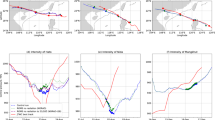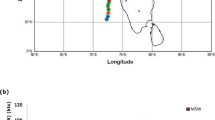Abstract
Tropical cyclones are the most devastating weather events which still needs to understand much due to the uniqueness in their paths and intensification locations. One such recent very severe cyclonic storm, Titli, is perfectly fit for the individual case study. The cyclone Titli originated from a low-pressure area formed over the southeast Bay of Bengal (BoB) and adjoining north of the Andaman Sea on 7th October 2018 and intensified into a very severe cyclonic storm on 10th over a region of low saline water pool in the western Bay of Bengal. The addition of low salinity water in this region is from the lower Mahanadi basin and surroundings that received excess rainfall in September 2018. The low saline waters developed high stratification and suppressed the upwelling at the cold-core eddy center and restricted to 50 m. Persistent high heat content and high internal energy are the primary sources of intensification of cyclone Titli. Generally, intense cyclones enrich biomass's enhancement in the ocean's surface layer after their passage. But in the case of Titli, biomass enrichment did not happen due to persistent high stratification, which is about 3–4. Even the 80 knots (150 km/h) winds cannot break up the upper layer stratification, suppressing the cyclone-induced upwelling. Observations show only a 0.2–0.4 mg/m3 rise in chlorophyll on the surface and it may be due to the land drove nutrients and lightning. Data analyzed from the high-resolution global NEMO model also shows the intrusion of low saline waters off India's east coast. Though the model is slightly overestimating the upwelling in the cold core eddy's surface layers, it represents the barrier caused by stratified waters. Both the observations and model datasets are well correlating, daily analyzed model data is well capturing the seasonal stratification caused by the low saline waters in the northern Bay of Bengal. These high-resolution global ocean model datasets are useful and essential for the accurate forecast of cyclones over the Bay of Bengal.











Similar content being viewed by others
References
Bender M A and Ginis I 2000 Real-case simulations of hurricane–ocean interaction using a high resolution coupled model: Effects on hurricane intensity; Mon. Wea. Rev. 128 917–946.
Blockley E W and Coauthors 2014 Recent development of the Met Office operational ocean forecasting system: An overview and assessment of the new Global FOAM forecasts; Geosci. Model Dev. 7 2613–2638, https://doi.org/10.5194/gmd-7-2613-2014.
Carine G van der Boog, Julie P, Henk D and Caroline A K 2019 The impact of upwelling on the intensification of anticyclonic ocean eddies in the Caribbean Sea; Ocean Sci. Discuss., https://doi.org/10.5194/os-2019-51.
Chang S W and Anthes R A 1978 Numerical simulations of the ocean’s nonlinear, baroclinic response to translating hurricanes; J. Phys. Oceanogr. 8 468–480.
Cornillon P, Stramma L and Price J F 1987 Satellite measurements of sea surface cooling during hurricane Gloria; Nature 326 373–375.
Emanuel K A 2001 The contribution of tropical cyclones to the oceans’ meridional heat transport; J. Geophys. Res. 106 14771–14781.
Lea D J, Mirouze I, Martin M J, King R R, Hines A, Walters D and Thurlow M 2015 Assessing a new data assimilation system based on the Met Office coupled atmosphere–land–ocean–sea ice model; Mon. Wea. Rev. 143 4678–4694.
Lin I I, Liu W T, Wu C C, Wong G T F, Chen C, Hu Z, Liang W D, Yang Y and Liu K K 2003 New evidence for enhanced ocean primary production triggered by tropical cyclone; Geophys. Res. Lett. 30 1718, https://doi.org/10.1029/2003GL017141.
Lin I I, Wu C C, Emanuel K A, Lee I H, Wu C R and Pun I F 2005 The interaction of supertyphoon maemi (2003) with a warm ocean eddy; Mon. Wea. Rev. 133 2635–2649.
Madhu N V, Maheswaran P A, Jyothibabu R, Sunil V, Revichandran C, Balasubramanian T, Gopalakrishnan T C and Nair K C 2002 Enhanced biological production off Chennai triggered by October 1999 super cyclone (Orissa); Curr. Sci. 82 1472–1479.
Maneesha K, Sarma V V S S, Reddy N P C, Sadhuram Y, Murty T V R, Sarma V V and Kumar M D 2011 Meso-scale atmospheric events promote phytoplankton blooms in the coastal Bay of Bengal; J. Earth Syst. Sci. 120 773–782, https://doi.org/10.1007/s12040-011-0089-y.
Monaldo F M, Sikora T D, Babin S M and Sterner R E 1997 Satellite imagery of sea surface temperature cooling in the wake of hurricane Edouard (1996); Mon. Wea. Rev. 125 2716–2721.
Neumann C J 1993 Global Overview. Chapter 1; Global Guide to Tropical Cyclone Forecasting; WMO/TC-No. 560 Report No. TCP-31 World Meteorological Organization Geneva Switzerland.
Prasanna Kumar S, Muraleedharan P M, Prasad N and Madhupratap M 2002 Why is the Bay of Bengal less productive during summer monsoon compared to the Arabian Sea?; Geophys. Res. Lett. 29 2235, https://doi.org/10.1029/2002GL016013.
Prasanna Kumar S, Nuncio M, Jayu Narvekar, Ajoy Kumar, Sardesai S, Desouza S N, Mangesh Gauns, Ramaiah N and Madhuprat 2004 Are Eddies nature’s trigger to enhance biological productivity in the Bay of Bengal?; Geophys. Res. Lett. 31 L07309, https://doi.org/10.1029/262003Gl019274.
Price J F 1981 Upper ocean response to a hurricane; J. Phys. Oceanogr. 11 153–175.
Shenoi S S C, Shankar D and Shetye S R 2004 Why is Bay of Bengal warmer than Arabian Sea during the summer monsoon?; Proceedings of the National Symposium METOC – 2004 on Emerging Trends in the Fields of Oceanography and Meteorology, 05–06 February 2004, pp. 87–93.
Tomczak M and Godfrey J S 1994 Regional oceanography: An introduction; Pergamon Press, Oxford.
Vinayachandran P N and Saji N H 2008 Mechanisms of south Indian Ocean intraseasonal cooling; Geophys. Res. Lett. 35 L23607, https://doi.org/10.1029/2008GL035733.
Wentz F J, Gentemann C, Smith D and Chelton D 2000 Satellite measurements of sea surface temperature through clouds; Science 288(5467) 847–850.
Acknowledgements
The authors acknowledge the Director, CSIR-NIO and Scientist-in-Charge for their support and providing the facilities. The authors are thankful to Dr Rashmi Sharma and Dr Mini Raman, Space Application Centre, Ahmedabad for their encouragement and support. The authors thank ISRO for providing funds through ISRO RESPOND Project OGP-204. This has the NIO contribution number 6754.
Author information
Authors and Affiliations
Contributions
KM conceived the idea, made all the calculations and interpretation, VSP and KV helped in the arrangement of data, figures and interpretation of physical, biological aspects, all the authors contributed to the development of the final manuscript.
Corresponding author
Additional information
Communicated by N V Chalapathi Rao
Rights and permissions
About this article
Cite this article
Maneesha, K., Prasad, V.S. & Venkateswararao, K. Ocean impact on the intensification of cyclone Titli. J Earth Syst Sci 130, 164 (2021). https://doi.org/10.1007/s12040-021-01660-9
Received:
Revised:
Accepted:
Published:
DOI: https://doi.org/10.1007/s12040-021-01660-9




